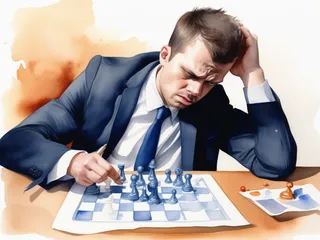I used to think strategic thinking was something you did in boardrooms with whiteboards and quarterly planning sessions. Then I became a Scrum Master and realized that the difference between strategic and reactive thinking shows up in dozens of small decisions every single day.
Watch any development team for a week, and you'll see both approaches in action. Some people consistently make choices that build toward something larger. Others solve immediate problems without considering the broader implications. The results compound over time in ways that dramatically impact both individual careers and team effectiveness.
The Reactive Trap in Technical Work
Here's what reactive thinking looks like in practice: A critical bug surfaces in production, so you patch it quickly without investigating the root cause. A stakeholder requests a feature change mid-sprint, so you accommodate it to keep them happy. A new technology trend emerges, so you immediately start advocating for adoption without considering integration costs.
Each individual decision seems reasonable in isolation. But string them together over months or years, and you end up with systems that are increasingly fragile, teams that are constantly firefighting, and careers that feel chaotic despite hard work.
I've seen talented developers get stuck in reactive cycles where they become the go-to person for urgent fixes but never get opportunities to work on interesting architectural challenges. They're so busy solving today's problems that they never build the skills or relationships that would give them better options tomorrow.
Strategic Thinking as a Daily Practice
Strategic thinking isn't about having a perfect long-term plan. It's about consistently asking better questions before making decisions.
Instead of "How can I fix this quickly?" you ask "What's the underlying pattern here, and how can I address it sustainably?"
Instead of "What does the stakeholder want right now?" you ask "What outcome are they actually trying to achieve, and what's the best way to get there?"
Instead of "What's the latest technology everyone's talking about?" you ask "What problems are we trying to solve, and what tools best fit our context and constraints?"
The Compound Effect of Better Questions
I learned this lesson while facilitating retrospectives. Teams that focused on immediate symptom relief ("We need better communication in Slack") made minimal progress over time. Teams that dug into systemic issues ("Why are we having communication breakdowns, and what structural changes would prevent them?") consistently improved their effectiveness.
The same principle applies to individual decision-making. When you consistently ask strategic questions, you start seeing patterns and opportunities that aren't visible from a purely reactive perspective.
Three Levels of Strategic Thinking
Tactical Strategy: Optimizing Your Current Context
This is about making your current role and team more effective. How can you automate repetitive tasks to create space for higher-value work? Which relationships should you invest in to improve collaboration? What skills would make you more valuable in your current context?
I've seen developers transform their careers by applying tactical strategy to mundane tasks. One teammate automated our deployment process not because it was assigned work, but because he recognized that reducing deployment friction would create opportunities for more frequent releases and better feedback loops. That initiative led to him becoming our DevOps lead.
Operational Strategy: Positioning for Better Opportunities
This involves making choices that create options for future roles and responsibilities. Which projects would teach you skills that transfer broadly? What cross-functional relationships would give you visibility into different parts of the business? How can you contribute to initiatives that align with company priorities?
When I transitioned from development to Scrum Master work, it wasn't through a formal career change program. I started volunteering to facilitate meetings, organizing team-building activities, and helping resolve interpersonal conflicts. By the time a Scrum Master position opened up, I had already demonstrated relevant skills and built relationships with key stakeholders.
Strategic Vision: Building Toward Long-Term Impact
This is about understanding the broader trajectory of your industry, company, or career and making choices that position you to contribute meaningfully to important trends.
For example, recognizing early that cloud adoption would reshape how software is built and operated, then developing relevant skills before they became mainstream requirements. Or identifying that cross-functional collaboration skills would become increasingly valuable as companies moved toward DevOps and product-focused teams.
Strategic Decision-Making Frameworks
The Time Horizon Test
Before making significant decisions, I consider multiple time horizons:
Immediate (next few weeks): What are the short-term costs and benefits? Medium-term (next few months): How does this affect my learning trajectory and relationship network? Long-term (next few years): Does this align with where I want my career to go?
The best strategic decisions create value across all three horizons, but when there are trade-offs, I usually optimize for medium-term learning and relationship building.
The Optionality Principle
Strategic choices should generally increase your future options rather than limit them. This means preferring roles that teach transferable skills over highly specialized ones, building relationships across different parts of the organization, and maintaining technical currency even as you take on more leadership responsibilities.
I've consistently chosen positions that combined technical challenges with people leadership opportunities. This kept multiple career paths open — I could go deeper into architecture, move into management, or focus on process improvement, depending on how my interests evolved.
The Systems Thinking Filter
Before addressing any problem, I try to understand the system that created it. Individual performance issues might reflect unclear expectations, inadequate tooling, or misaligned incentives. Technical debt might result from resource constraints, changing requirements, or knowledge gaps.
Addressing symptoms provides temporary relief. Understanding and influencing systems creates lasting change.
Common Strategic Thinking Pitfalls
Over-Planning vs. Under-Adapting
Some people interpret strategic thinking as creating detailed long-term plans, then rigidly executing them regardless of changing circumstances. This is strategic planning, not strategic thinking.
Strategic thinking means maintaining clear principles and direction while adapting tactics based on new information. Your core values and growth vectors remain stable, but your specific goals and methods evolve as you learn more about yourself and your environment.
Analysis Paralysis vs. Informed Action
Another extreme is getting so caught up in strategic analysis that you never take action. The goal isn't perfect information — it's making better decisions with the information you have.
I use a simple threshold: if a decision is reversible and the downside is manageable, I optimize for learning speed over perfect analysis. If a decision is difficult to reverse or has significant downside risk, I invest more time in strategic evaluation.
Short-Term Sacrifice vs. Sustainable Intensity
Strategic thinking doesn't mean constantly sacrificing present happiness for future benefits. Sustainable strategies account for your current well-being and motivation levels.
I've learned to look for opportunities that are challenging enough to drive growth but not so overwhelming that they undermine my effectiveness or work-life balance. The most successful strategic moves have been ones that felt energizing rather than purely sacrificial.
Building Strategic Muscle
Like any skill, strategic thinking improves with deliberate practice. Start by applying these frameworks to smaller decisions and gradually work up to bigger ones.
Pay attention to the outcomes of decisions you make strategically versus reactively. Notice which approaches lead to better results over time.
Most importantly, regularly step back from the immediate demands of your work to assess whether your day-to-day choices are building toward something meaningful or just keeping you busy.
The Competitive Advantage of Strategic Thinking
In a fast-moving industry where technical skills become obsolete quickly, the ability to think strategically becomes a sustainable competitive advantage. You can't predict which specific technologies will dominate in five years, but you can develop the judgment to evaluate new tools effectively and the learning agility to adapt to change.
Strategic thinkers consistently end up with better opportunities, not because they're luckier, but because they've positioned themselves to recognize and capitalize on possibilities that others miss.
The difference between reactive and strategic living isn't just about career outcomes — it's about feeling like you're building something meaningful rather than just responding to whatever comes next.





